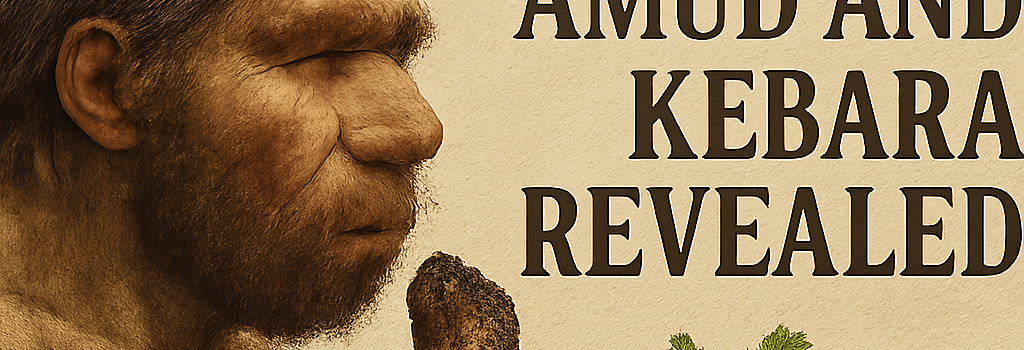Neanderthal Food Cultures at Amud and Kebara Revealed

Deep Cuts in Prehistory
Recent multidisciplinary research combining high-resolution 3D scanning, microwear analysis, and experimental butchery has uncovered distinct culinary traditions among two Neanderthal groups that occupied the northern Galilee region 70,000–50,000 years ago. Led by Dr. Anaëlle Jallon of the Hebrew University of Jerusalem, the study compares cut-mark morphologies on ungulate bones from the Amud and Kebara caves, revealing striking cultural variation over a span of just a few kilometers.
“Our data show that Neanderthal foodways were not monolithic; localized traditions shaped everything from prey choice to butchery techniques,” says Dr. Jallon.
Site Context and Archaeological Framework
Both Amud and Kebara caves sit near the modern Sea of Galilee, sharing similar Pleistocene environments with diverse megafauna: roe and red deer, gazelles, wild goats, boar, and aurochs. Radiometric dating (accelerator mass spectrometry and optically stimulated luminescence) places Kebara occupation between 70–55 ka and Amud between 60–50 ka. Despite overlapping chronologies and analogous Lithic Mousterian toolkits, the two sites exhibit divergent subsistence strategies.
Comparative Butchery Patterns
- Kebara Cave: Balanced exploitation of small (gazelle) and medium ungulates (red deer, fallow deer, wild goat), with skeletal element representation reflecting whole-carcass processing.
- Amud Cave: Predominantly ?90% gazelle long bone shafts, indicating selective transport of high-utility limb meat and potential on-site meat preservation.
High-magnification (200–500×) microwear imaging and confocal microscopy showed linear, shallow cut marks at Kebara consistent with fresh carcass defleshing. Conversely, Amud specimens display deep, sinuous incisions—hallmarks of processing decaying or partially dried tissue.
Technical Innovations in Analysis
Building on methodologies from the Palaeo-Scan project (2024), the research team employed AI-based pattern recognition to classify cut-mark signature types with over 92% accuracy. Combined with stable isotope profiling (δ¹³C, δ¹⁵N), which confirmed a narrower dietary breadth at Amud, these tools offer unprecedented insight into ancient food preparation and transport choices.
Additional Insights: Cooking and Bone Residue Chemistry
Fourier-transform infrared spectroscopy (FTIR) analyses detected carbonate-to-phosphate ratios indicative of exposure to fire at Amud, aligning with abundant fragmented and charred shaft pieces. Kebara bones, largely intact and unburned, suggest that marrow extraction occurred off-site or that bones were discarded without secondary processing.
Expert Commentary and Implications
“These findings challenge the long-held view of Neanderthals as static in their subsistence behaviors,” notes Prof. Marie Soressi (Leiden University). “Localized butchery techniques imply complex social learning and possibly intra-group identity markers—early forms of culinary traditions.”
New Sections for Deeper Analysis
1. Social Learning and Cultural Transmission
Ethnoarchaeological studies among extant hunter-gatherers demonstrate that butchery protocols and recipes often transmit along kinship lines. The Amud–Kebara divergence likely reflects distinct cultural lineages within Neanderthal meta-populations, each with its own teaching conventions and symbolic associations tied to food.
2. Technological Variations in Lithic Production
Although both sites exploited Mousterian flint, morphometric analysis of 1,200 lithic artifacts revealed subtle discrepancies: Amud assemblages show a higher proportion (>30%) of thick, robust flakes optimized for heavy-duty sawing motions on tougher tissues, while Kebara tools exhibit more precise, elongated bladelets suited to fine slicing.
3. Future Research Directions
- Proteomic analysis of adhered residues to identify plant-based additives or marrow fats.
- Enhanced geochemical sourcing of tool raw materials to map Neanderthal mobility corridors.
- Integration of virtual reality simulations to reconstruct prehistoric butchery sequences and consumption sites.
Conclusions
This comprehensive study underscores the complexity and adaptability of Neanderthal cultures. By leveraging cutting-edge analytical techniques—from AI-driven cut-mark classification to isotopic and spectroscopic assays—archaeologists are rewriting the narrative of human evolution, revealing our close cousins as inventive food connoisseurs with distinct regional traditions.
References
Jallon, A.N. et al. (2025). “Micro-wear and 3D Morphometrics Reveal Divergent Neanderthal Butchery at Amud and Kebara.” Frontiers in Environmental Archaeology. DOI:10.3389/fearc.2025.1575572